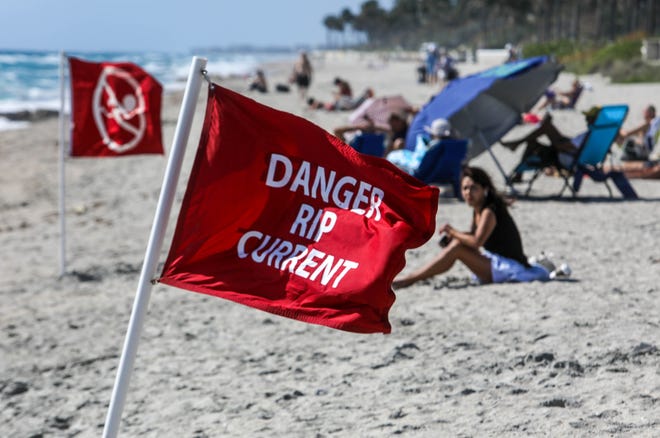A deadly low tide off the coast of Panama City, Florida, killed four people within 48 hours, tragically leaving the area likely to remain one of the most dangerous coastlines in the US this year.
Authorities said the bodies of the three young people were discovered, one by one, on Friday evening after they had traveled to Panama City from Alabama several hours earlier.
Rescue crews tried unsuccessfully to save a 19-year-old man who was swimming behind Sharkey’s Beachfront Restaurant in Panama City Beach on Thursday afternoon.
Rip currents have claimed more lives in Panama City than anywhere else in the U.S. in 2023, according to data from the National Weather Service. At least eight people died. Across Florida, more than 30 people died in rip currents last year. Five people died in New Jersey, and three each in California, South Carolina and Louisiana.
Beaches, often crowded in the summer, harbor a hidden danger: fast-flowing waters that can pull swimmers from shore and exhaust those struggling to get out. The National Ocean Service estimates that thousands of people are rescued from rip currents in the United States each year.

Rip currents can occur anywhere there are breaking shorelines, including the Great Lakes, but the waters off the coast of Florida have proven to be some of the most dangerous. At least six people have died on Florida beaches this week alone, bringing to 11 the number of people who have drowned in rip currents elsewhere in the U.S. and its territories this year through June 9.
Tourists die in dangerous rip currents in Florida
At least six people visiting from out of state have died in a series of drownings off Florida’s coasts in recent days.
Tragedy struck Panama City on Friday, when three men visiting from Alabama drowned in the ocean amid high waves, strong currents and a single red flag signifying dangerous conditions.
According to the Bay County Sheriff’s Office, the men arrived in the area in the early afternoon. Harold Denzel Hunter, 25, Jemonda Ray, 24, and Marius Richardson, 24, all from the Birmingham area, went into the water around 8 p.m. The men had checked into an oceanfront condo for the night and had planned to go shopping but wanted to go for a swim first.
Just 10 minutes later, the sheriff’s office responded to a call about swimmers in distress, including other members of the group, women who had made it ashore before the men were lost in the Gulf of Mexico.
Hunter, Ray and Richardson were each found less than a half mile from where they entered the water, and all three were taken to a local hospital where they were pronounced dead.
A 19-year-old man visiting from Oklahoma drowned Thursday when he was caught in a low tide off the coast of Panama City Beach. Ryker Milton was in his first year of online seminary training and was supervising student pastors at New Community Church, a nondenominational Christian church, Senior Pastor Simeon Young told the Panama City News-Herald, part of the USA Today Network.

A Pennsylvania couple died Thursday after being caught in a rip current off the coast of Hutchinson Island in Stuart Beach, authorities said. Brian Waters, 51, and Erica Wishard, 48, were vacationing with their six children when two of their teenage children were caught in the rip current. The two teenage children were able to escape the current.
Live UpdatesThree young people drown in Gulf of Mexico in Bay County, Florida
See how rip currents work:Graphic showing how rip currents pose a danger to swimmers
Rip currents claim dozens of lives each year.
About 91 people died in rip currents on U.S. beaches last year, according to data from the Weather Service, up from the 10-year average of 74 per year. Most people who drown in rip currents and other wave hazards are boys and men between the ages of 10 and 29, and most of the deaths occur in June and July, according to the data.
Experts say rip currents are so dangerous because they can cause swimmers to panic and try to swim toward shore, causing them to tire out before they can escape the current.
Officials urge people to always check water conditions before entering the ocean and to swim near a lifeguard. In Florida, it is illegal to swim during double red flags, which indicate the most dangerous conditions. A single red flag means strong rip currents are expected and people are advised not to enter the water.
Panama City Beach death toll continues to record
Most water rescues in Panama City Beach happen when only one red flag is up, Darryl Paul, beach safety director for Panama City Beach Fire Rescue, told the Panama City News Herald, part of the USA Today Network. Even when the waves appear calm, deadly rip currents can occur, he said. While last year’s fatal accident occurred when only one red flag was up, seven other accidents in Bay County happened when two red flags were up in very rough surf conditions.
“The waves aren’t killing people here. The waves themselves aren’t the danger. It’s the rip currents that are the danger, and that’s why we have the flags up,” Paul said.
If you get caught in a rip current, try to stay calm. Instead of swimming towards shore, swim parallel to the shore and, once you’re out of the current, swim diagonally back to land.
Contributors: Claire Thornton, Dinah Boyles Pulver, USA Today, Nathan Cobb, Leanna Norman, CA Bridges, Panama City News Herald

